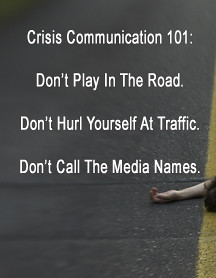With no official word from CBS, fans of the cancelled, resuscitated, and now on the bubble show, Jericho, are taking no chances. For several weeks, they have been writing letters and hoisting up banners of the “Don’t Tread On Me” flag that appears in one of the episodes of the second season. No more nuts yet.
Many critics have warmed to the show, but maintain it’s unlikely to see a third season. Some are even campaigning for faith in the rating system and against renewal, despite saying they like it.
The latter criticism came after Patrick Keane, vice president and chief marketing officer for CBS Interactive, speaking Monday at MediaPost's OMMA Global conference in Hollywood, used Jericho as an example of how online audiences can have a positive impact on a show, especially because online viewership doesn’t cannibalize the broadcast audience.
The online video audience for one episode of Jericho boosted the show's TV ratings by almost a full point: from 4.2 to 5.1.
Even for those who have never seen the show, the significance is in that it represents the transition for television. As cross-convergence seems eminent, Jericho provides a glimpse into just how forward-thinking networks can be, if they want to be.
With two different episodes — one that offers closure and another that provides a cliffhanger — CBS can justify a Jericho renewal as easily as a cancellation. Enough so that I wouldn’t want to hazard a guess. See for yourself…
Five Reasons To Keep Jericho
• Fans are engaged, watching episodes and embedded ads over and over.
• The online audience continues to grow, with ample consumer evangelists.
• Even with less-than-stellar ratings, the rating are better than many other shows.
• It’s a leading program among the network’s growing online inventory.
• There were notable flaws in engaging the fan base that saved the show while CBS continues to get up to speed on how to best engage online fans. There is an opportunity to do it right with a third season.
Five Reasons To Let Jericho Go
• The ratings are just not there; no matter how flawed the system.
• The fan base did not meet Nina Tassler’s condition of more live viewers.
• The fans were never able to develop solidarity or sustained buzz.
• The network met its commitment to deliver a wrap-up with seven episodes.
• There are too many financial limitations to give the show the budget it needs.
Of course, there is also the possibility that network executives at CBS have secretly acquired a taste for nuts. But that is purely speculative.
The real questions CBS might ask is what kind of network does it want to be. Is there an opportunity to take the lead position as an online content provider? Is Jericho the right show to help usher in a new era? And can it preserve this fan base to help lift up new original content in the future?
Everything tells me that the network is split on the decision. Rumors suggest that CBS may be answering these questions as early as today. The clock is ticking and the worst thing the network could do is keep its decision a cliffhanger. Maybe part of the answer lies in non-traditional thinking: Jericho has helped boost other CBS and CW programs online and provided more brand recognition for the network than broadcast ever did on its own.

Many critics have warmed to the show, but maintain it’s unlikely to see a third season. Some are even campaigning for faith in the rating system and against renewal, despite saying they like it.
The latter criticism came after Patrick Keane, vice president and chief marketing officer for CBS Interactive, speaking Monday at MediaPost's OMMA Global conference in Hollywood, used Jericho as an example of how online audiences can have a positive impact on a show, especially because online viewership doesn’t cannibalize the broadcast audience.
The online video audience for one episode of Jericho boosted the show's TV ratings by almost a full point: from 4.2 to 5.1.
Even for those who have never seen the show, the significance is in that it represents the transition for television. As cross-convergence seems eminent, Jericho provides a glimpse into just how forward-thinking networks can be, if they want to be.
With two different episodes — one that offers closure and another that provides a cliffhanger — CBS can justify a Jericho renewal as easily as a cancellation. Enough so that I wouldn’t want to hazard a guess. See for yourself…
Five Reasons To Keep Jericho
• Fans are engaged, watching episodes and embedded ads over and over.
• The online audience continues to grow, with ample consumer evangelists.
• Even with less-than-stellar ratings, the rating are better than many other shows.
• It’s a leading program among the network’s growing online inventory.
• There were notable flaws in engaging the fan base that saved the show while CBS continues to get up to speed on how to best engage online fans. There is an opportunity to do it right with a third season.
Five Reasons To Let Jericho Go
• The ratings are just not there; no matter how flawed the system.
• The fan base did not meet Nina Tassler’s condition of more live viewers.
• The fans were never able to develop solidarity or sustained buzz.
• The network met its commitment to deliver a wrap-up with seven episodes.
• There are too many financial limitations to give the show the budget it needs.
Of course, there is also the possibility that network executives at CBS have secretly acquired a taste for nuts. But that is purely speculative.
The real questions CBS might ask is what kind of network does it want to be. Is there an opportunity to take the lead position as an online content provider? Is Jericho the right show to help usher in a new era? And can it preserve this fan base to help lift up new original content in the future?
Everything tells me that the network is split on the decision. Rumors suggest that CBS may be answering these questions as early as today. The clock is ticking and the worst thing the network could do is keep its decision a cliffhanger. Maybe part of the answer lies in non-traditional thinking: Jericho has helped boost other CBS and CW programs online and provided more brand recognition for the network than broadcast ever did on its own.





















